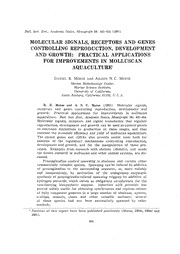
MOLECULAR SIGNALS, RECEPTORS AND GENES CONTROLLING REPRODUCTION, DEVELOPMENT AND GROWTH: PRACTICAL APPLICATIONS FOR IMPROVEMENTS IN MOLLUSCAN AQUACULTUREl PDF
Preview MOLECULAR SIGNALS, RECEPTORS AND GENES CONTROLLING REPRODUCTION, DEVELOPMENT AND GROWTH: PRACTICAL APPLICATIONS FOR IMPROVEMENTS IN MOLLUSCAN AQUACULTUREl
Bull. Inst. Zool., Academia Sinica, Monograph 16: 441-454 (1991) MOLECULAR SIGNALS, RECEPTORS AND GENES CONTROLLING REPRODUCTION, DEVELOPMENT AND GROWTH: PRACTICAL APPLICATIONS FOR IMPROVEMENTS IN MOLLUSCAN AQUACULTUREl DANIEL E. MORSE and AILEEN N. C. MORSE Marine Biotechnology Center, Marine Science Institute, University of Caltfornia, Santa Barbara, California 93106, U. S. A. D. E. Morse and A. N. C. Morse (1991) Molecular signals, receptors and genes controlling reproduction, development and growth: Practical applications for improvements in molluscan aquaculture. Bull. Inst. Zool., Academia Sinica, Monograph 16: 441-454. Molecular signals, receptors and signal transducers that regulate reproduction, development and growth can be used as control points to overcome limitations to production at these stages, and thus increase the economic efficiency and yield of molluscan aquaculture. The cloned genes and cDNAs also provide· useful tools both for analysis of the regulatory mechanisms controlling reproduction, development and growth, and for the manipulation of these pro cesses. Examples from research with abalone (Haliotis), and needs for future research in molluscan and other animal systems, are dis cussed. Prostaglandins control spawning in abalones and certain other commercially valuable species. Spawning can be induced by addition of prostaglandins to the surrounding seawater, or, more reliably and inexpensively, by activation of the endogenous enzymatic synthesis of prostaglandin-related spawning triggers by addition of hydrogen peroxide, which serves as obligatory co-substrate for the rate-limiting biosynthetic enzyme. Induction with peroxide has proved widely useful for obtaining synchronous and copious release of fully competent gametes in a large number of abalones, oysters, scallops, mussels, clams and other valuable molluscs; several of these species had not been successfully spawned by other methods. Portions of this report have been published previously (Morse, 1984a, 1984d and 1 1991). 441
